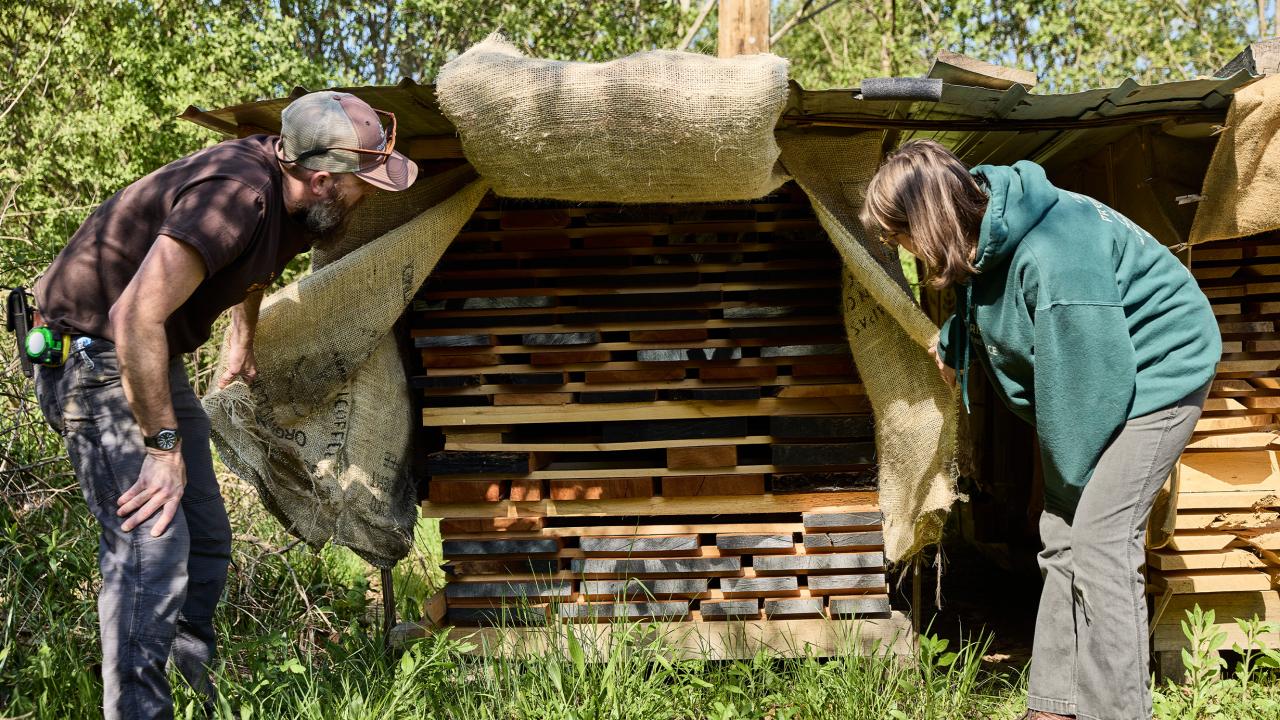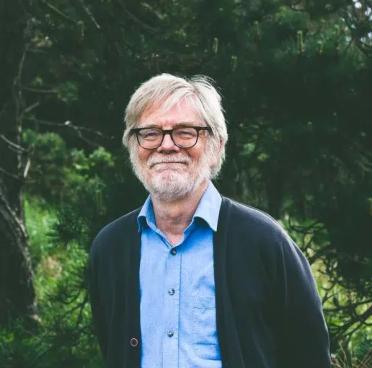
Stewards of the Forest: Ringing True
Image: Brian Brace and apprentice Anna Sullivan at his site in Black Mountain, North Carolina. Photography by Petr Krejci.
Stewards of The Forest: Stories of the people behind the diverse naturally regenerated hardwood forests of the eastern United States
Ringing True
For Jayne it is the sound the wood makes when you tap it; for Brian it is the color and grain. For both these wood crafters, the oak and maple, cherry and walnut that they salvage from the streets and gardens of Asheville in North Carolina are gold dust. Trees that would otherwise be cut up for firewood deliver boards of immense beauty and captivating acoustics, finding a new life in their high-end furniture and musical instruments.
It is an intriguing paradox that city trees on the southern flank of the Blue Ridge Mountains are among the oldest and best in America. They are survivors of the ancient forests that once covered most of the area. “A hundred years ago, whole hillsides around here were clear-cut,” says furniture-maker Brian Brace from his wood yard by railroad tracks at Black Mountain, just outside Asheville. “But within the city limits, protected in gardens and down sidewalks, a lot of trees never got cut.”
To make his up-market designer furniture, Brian is constantly listening out for news of fallen and dangerous trees that need removing. The older the tree the better, he says. “Older logs have tighter growth rings. That gives them greater structural stability, which really matters because I am making furniture that could have a lifetime of a hundred years.”
Today, he is inspecting a giant white oak log, more than three feet in diameter and probably 150 years old. “A guy in West Asheville called me up. He had a fallen tree. He was going to cut it into firewood. But I had my sawyer Billy run right over.” As we talk, Billy is getting ready to turn that log into boards. As his mobile sawmill cuts through the log, the heart is exposed, revealing beautiful unblemished grain. Brian leaps onto the log in raptures. “Wow, that’s awesome. Beautiful,” he shouts. “We caught it at the perfect time. I can build at least ten chairs from this one log.”
--
Asheville is the cool, hipster capital of the New South, a centre for hundreds of craft workers, including hardwood artisans like Brian and Jayne. The Blue Ridge Mountains close by are a big draw for such aesthetes.
The Mountains’ forests suffered carnage up to a century ago, when the region was at the centre of an orgy of felling of Eastern American hardwood forests, taken for charcoal and firewood, the masts of warships, railroad ties and building construction. But, after the carnage, North Carolina was also at the heart of the slow recovery of those forests, which are now a major attraction for tourists and residents alike.
George Vanderbilt’s Biltmore estate, just outside Asheville, was the home of the country’s first forest school and pioneered techniques for more sustainable forestry and re-establishing lost forests through natural restoration. It became known as the country’s “cradle of forestry”.
Today, the hardwood forests in the mountainous west of North Carolina, around Asheville and along the Blue Ridge Parkway, contain a greater diversity of tree species than anywhere else in the Eastern U.S. Thanks to the legacy of forest conservation and stewardship – quite unlike the rapacious clear-felling and monoculture plantations of softwoods that continues further west – they are growing more than twice as much timber as is harvested.
But even now, the regrowing forests cannot offer the magical old trees found in downtown Asheville.
There, luthier Jayne Henderson is in the workshop she has created in the basement of her suburban home, putting the finishing touches to a ukelele, her favorite instrument for both making and playing. It took two weeks to make, using simple hand tools, and was pre-sold for several thousand dollars.
Jayne trained as an environmental lawyer, but followed her father, the locally famous guitarist Wayne Henderson, into acoustic instrument making. “I grew up in the Appalachian Mountains surrounded by trees. But I had no idea I could love producing something from them with my own hands, until I worked in my father’s workshop to pay college fees. Being able to see the wood and know that you can make it come alive as an instrument was incredible. I started my own business and I have been doing it for 12 years.”
A lot of her fellow luthiers make their instruments from tropical hardwoods. But not Jayne. “Those exotics are getting scarce,” she says. There have been scandals over guitar makers using illegally cut Brazilian rosewood, Madagascan ebony and other protected tree species. But it is so unnecessary, she says. “Our local hardwoods here in North Carolina have the same density and are special in their own right.”
Spoilt for choice, she has become an afficionado of the best wood for making her instruments. “They just speak to me,” she says. “Wood transmits sound in a way quite unlike any other material. There is no good substitute, but each is unique. I tap the wood with my finger and the longer it makes a hum, and the brighter and more resonant it sounds, the better. I can tell it will make a really good instrument. It’s a magical connection.”
Like Brian, she has a local network to find the wood she needs. “People know I make instruments only from local wood. I’ll get a call from someone saying ‘my prized walnut tree fell down. Could you make something lovely out of it, to keep it alive?’”
She prizes her relationships with her clients, too. “I can sometimes see a piece of wood and know it is right for them, because it mirrors their personality somehow.” She strums the completed ukelele, knowing who it is for, and why.
As we finish, she heads out her front door, past a large oak tree in the garden that may one day have its place on her workbench. She is off to collect her daughter Matilda and their dog, for a walk in the woods. Is Matilda destined to become a third generation luthier? Maybe.
--
Unlike Jayne, Brian had no family link to woodworking. Just a love of the material. He began making furniture as a 15-year-old apprentice, after badgering a local craftsman he knew from basketball in his home state of Vermont. Today, 28 years later, he makes and sells his own signature chair design, as well as tables, desks and other domestic furniture. “I use 100% local solid wood and traditional joinery. My furniture will last for generations,” he says.
He recently became North Carolina’s only Roycroft Master Artisan, an elite group of traditional hand crafters dedicated to working in the arts-and-crafts style. And he has recruited his own apprentice, 20-year-old Anna Sullivan – a rare woman in a business still dominated by men.
“I’ve grown up amid the trees, and I love using local wood. I love the smell of wood and its textures and densities,” Anna says. “Especially cherry, its grain and color, the way it changes with the light and darkens over time – and seeing it turned into things in people’s homes. I’ve been doing this for five years, but I still feel like I am only scratching the surface,” she says. “It’s going to be my career, for sure.”
And with the forest trees growing big and strong all around us through the Blue Ridge Mountains, even if the urban trees eventually give out, Anna will never be short of raw materials.
